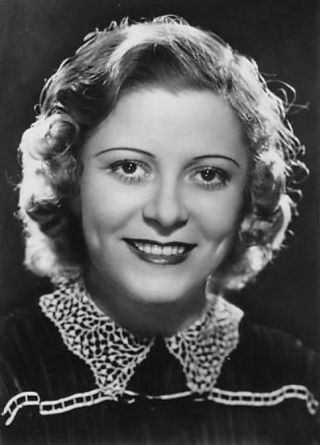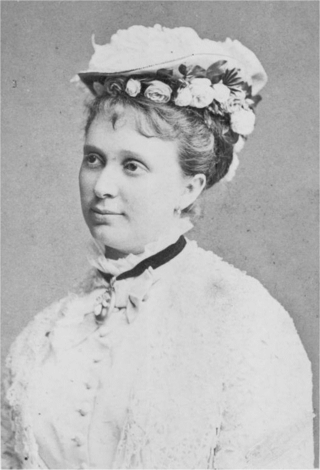Related Research Articles

Maria Cebotari was a Bessarabian-Romanian lyric coloratura soprano. She was widely known as a singer by the mid 1930s and noted in particular for her wide range of repertoire.
In music, a canzonetta is a popular Italian secular vocal composition that originated around 1560. Earlier versions were somewhat like a madrigal but lighter in style—but by the 18th century, especially as it moved outside of Italy, the term came to mean a song for voice and accompaniment, usually in a light secular style.

Ljuba Welitsch was an operatic soprano. She was born in Borisovo, Bulgaria, studied in Sofia and Vienna, and sang in opera houses in Austria and Germany in the late 1930s and early and mid-1940s. In 1946 she became an Austrian citizen.

Irmgard Seefried was a distinguished German soprano who sang opera, sacred music, and lieder.

Anna Bellschan von Mildenburg was an eminent Wagnerian soprano of Austrian nationality. Known as Anna Bahr-Mildenburg after her 1909 marriage, she had been a protégé of the composer/conductor Gustav Mahler during his musical directorship at the Hamburg State Opera. In 1898, Mahler took her to the Vienna State Opera, where she established herself as one of the great stars during his celebrated tenure there as music director.

Benedikt Emanuel Schack was a composer and tenor of the Classical era, a close friend of Mozart and the first performer of the role of Tamino in Mozart's opera The Magic Flute.

Maria Josepha Weber was a German soprano of the classical era. She was a sister-in-law of Wolfgang Amadeus Mozart, and the first to perform the role of The Queen of the Night in Mozart's opera The Magic Flute (1791).

Marianna Martines, also Marianne von Martinez, was a composer, pianist, and singer of the classical period, based in Vienna, Austria.

Hildegard Zadek was a German operatic soprano. She was Kammersängerin at the Vienna State Opera and performed internationally.
Soprano sfogato is a contralto or mezzo-soprano who is capable — by sheer industry or natural talent — of extending her upper range and encompassing the coloratura soprano tessitura. An upwardly extended "natural" soprano is sometimes called soprano assoluto.

Mathilde Mallinger was a Croatian lyric soprano opera singer.

Eugenia Tadolini was an Italian operatic soprano. Admired for the beauty of her voice and stage presence, she was one of Donizetti's favourite singers. During her career she created over 20 leading roles, including the title roles in Donizetti's Linda di Chamounix and Maria di Rohan and Verdi's Alzira. She was born in Forlì and studied music there and in Bologna before making her debut in Florence in 1828. She sang in all of Italy's leading opera houses, as well as in Paris, Vienna, and London before retiring from the stage in 1852. She spent her remaining years first in Naples, where she had been the Teatro San Carlo's reigning prima donna for many years, and then in Paris, where she died of typhoid fever at the age of 63. From 1827 to 1834, she was married to the Italian composer and singing teacher, Giovanni Tadolini.
Adelheid Maria Eichner (1762–1787) was a German composer, singer and pianist who was noted during her brief lifetime for her fine three-octave singing voice and vocal technique. She was the only child of bassoonist and composer Ernst Eichner and his wife, Maria Magdalena Ritter. Critics claim her compositions to be more effective instrumentally than vocally. As a composer, Adelheid Eichner had difficulty combining words and music effectively.

Marianne Müller, née Hellmuth was a German soprano and actress.

Margarete Luise Schick, was a German operatic soprano. A member of the Berlin Royal Opera, she was known for interpreting leading roles in operas by Gluck, singing in German with precise diction, and acting convincingly. She was a soloist at the coronation of Leopold II, with Mozart conducting.

Anna Juliane Bochkoltz was a German operatic soprano, voice teacher and composer. She performed her first concert in 1843, then studied in Brussels and Paris. After singing concerts in Paris, London and Berlin, she appeared in the 1850s on opera stages in Wiesbaden, Frankfurt, Munich and Coburg. She was known for the range of her voice, and was regarded as one of the important dramatic coloratura sopranos of her era, appearing as Mozart's Donna Anna, Beethoven's Fidelio and Bellini's Norma. She later taught singing in Vienna, Strasbourg and Paris.

Anna Maria Sessi, later known as Anna Maria Neumann-Sessi, was an Italian-born soprano primarily active in the opera houses of Vienna and Leipzig.

Friederike Funk, married name La Grua bzw. Funk La Grua was a German operatic soprano and Royal Saxon Kammersinger in Dresden.
Caroline Willmann was a German operatic soprano, and in her early career a pianist. She was one of a family of musicians.
Marianne Willmann was a German operatic soprano. She was one of a family of musicians.
References
- ↑ Wier, Albert E. (1938). The Macmillan Encyclopedia of Music and Musicians. New York: Macmillan. p. 1721.
- 1 2 3 4 5 6 7 8 9 10 11 Cohen, Aaron I. (1987). International Encyclopedia of Women Composers. Books & Music (USA). ISBN 978-0-9617485-2-4.[ page needed ][ failed verification ]
- 1 2 Albrecht, Carol (2008). "Music in Public Life Viennese Reports from the Allgemeine Musikalische Zeitung, 1798–1804". p. 141 and others.
- ↑ Stewart-Green, Miriam (1980). Women composers : a checklist of works for the solo voice. Boston, Massachusetts: G. K. Hall. ISBN 0-8161-8498-4. OCLC 6815939.
- 1 2 U. Harten (1976). "Natorp, Maria Anna (Marianne) Freifrau von; geb. Sessi (1773–1847), Sängerin und Komponistin". Österreichisches Biographisches Lexikon 1815–1950 (in German). pp. 38–39. doi:10.1553/0x0028358e . Retrieved 2022-07-23.
- ↑ Stern, Susan (1978). Women Composers: A Handbook. Metuchen, New Jersey: Scarecrow Press. ISBN 0-8108-1138-3. OCLC 3844725.
- 1 2 "Sessi-Natorp, Marianna" (in German). Carl-Maria-von-Weber-Gesamtausgabe. 6 January 2022. Retrieved 22 July 2022.
- ↑ Mendel (1880). Musikalisches Konversationslexikon: eine Encyklopedie der gesammten musikalischen Wissenschaften für Gebildete aller Stände (in German).
- ↑ Kutsch, Karl-Josef; Riemens, Leo (2012-02-22). "Sessi, Marianne". Großes Sängerlexikon (in German). Walter de Gruyter. p. 4365. ISBN 978-3-598-44088-5.
- 1 2 3 4 Fétis, François-Joseph (1867). Biographie universelle des musiciens et bibliographie générale de la musique (in French). Firmin Didot.